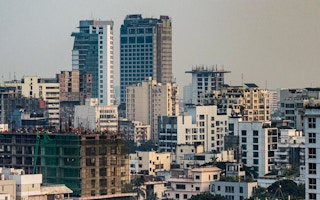Md Dulal Miya, 35, works as a “plant doctor” at Dhaka-based Green Savers, a city greening organisation that plants and tends to trees and gardens on rooftops, balconies and in office campuses, with clients from households to businesses.
In rapidly urbanising Bangladesh, whose capital has seen its population jump to 23 million people today from around 6.6 million people in 1990, green space and vegetation have eroded fast, giving way to buildings and concrete infrastructure.
Fighting against this grey tide and the extra heat it fuels, Green Savers has pioneered rooftop and schoolyard gardens, urban farms and tree-planting in crowded and polluted Dhaka.
According to Green Savers, while a liveable city should contain 25 per cent greenery, Dhaka barely has 5 per cent, including only about 2 per cent of the city’s 4.5 million rooftops.
Founded in 2010, the organisation has so far trained about 1,000 “plant doctors”, who help its clients cultivate green spaces in often densely built-up areas.
“
When I ride my bicycle along the roads of the hot, humid climate of Dhaka, I can feel on my skin the palpable difference between greener neighbourhoods and barren ones.
Md Dulal Miya, plant doctor, Green Savers
Seeking to play its part in tackling climate change, Green Savers has created more than 5,000 home gardens and worked with at least 200 schools, while some of its trainees have joined other outfits or become entrepreneurs themselves.
Through his work with Green Savers, Miya has discovered the health and nutritional benefits of increasing urban vegetation.
Why did you choose this job?
“I lost my mother early on and my father, a landless peasant, relied on farming on leased land to provide for his three children. The usual floods in my home district of Netrokona (in central Bangladesh) would quite often result in crop failures - and the hardship in our family was difficult to endure.
I chose to move to Dhaka about 10 years ago and took up a job in a nursery. That is where I got in touch with Ahsan Rony, the founder of Green Savers, who would procure plants from the nursery. As I learned about his organisation, I felt interested and, eventually, I joined Green Savers.
I received three months of training on various aspects of gardening, such as how to grow plants on rooftops, balconies or even indoors, the main diseases and growth challenges for plants, and how to tackle those with proper use of fertilisers and pesticides.
I also learned about emerging innovative techniques like hydroponics - whereby one can grow plants without soil and vertical greening along the walls of a building.”
What do you enjoy about the job?
“I help clients grow a range of plants such as guava, lemon, malta, mango, orchids, roses and so forth. I am providing support to five clients at the moment. Since (they) do not necessarily have technical knowledge about plants, they sometimes get concerned as to why the trees are not growing faster or bearing fruits earlier. However, my training equips me to allay their concerns and provide solutions to any problems that may arise.
The work is emotionally rewarding, besides ensuring a steady income to my family of four. When I ride my bicycle along the roads of the hot, humid climate of Dhaka, I can feel on my skin the palpable difference between greener neighbourhoods and barren ones. The clients can get safe fruits and vegetables from the gardens, while whole neighbourhoods benefit from the fresh air and oxygen, thanks to the gardens. I am raising and educating my two daughters with my earnings, while trying to cope with soaring prices of essentials.
Beyond Dhaka, we have worked on major projects in other parts of the country. I was part of landscaping and gardening activities in Sylhet (in eastern Bangladesh), for example. There are many more projects with a range of clients as interest in urban farming is on the rise.”










